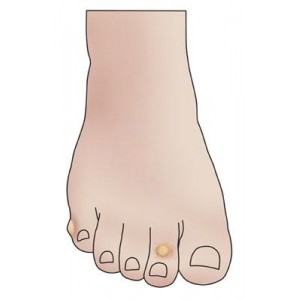Corn
Corn:Corns like calluses develop from an accumulation of dead skin cells on the foot, forming thick, hardened areas. They contain a cone-shaped core with a point that can press on a nerve below, causing pain. Corns are a very common ailment that usually form on the tops, sides and tips of the toes. Corns can become inflamed due to constant friction and pressure from footwear. Corns that form between the toes are sometimes referred to as soft corns.
Symptoms:Corns are usually regular in shape and can be white, gray, or yellow. They most often form on the outside of the fifth toe, since this is the point that pressure most often occurs. Corns that form between the toes are called soft corns, and they are not as firm as other corns because of moistness between the toes.
Causes:Some of the common causes of corn development are:
Prevention:Wear comfortable shoes. Ill-fitting footwear often causes corns and calluses. Wear shoes that do not cramp your toes.Look at the heels on an old pair of shoes. If one side is markedly worn, you may be shifting your weight unevenly as you walk. Ask your physician or podiatrist if a shoe insert (orthotic) could help distribute your weight more evenly.Protect your skin. Visit your pharmacy or medical supply store.
Treatment:Corns are best treated by first eliminating the cause of the pressure. Over-the-counter preparations are available. These include padding (to reduce the friction on the area), ointments and medicated pads (to soften and blister the skin layers, making them easier to remove and reducing the pain). If the problem persists, consult your foot doctor.
Warning: We hope these suggestions improve your health and make you more comfortable. However, if you have any concerns about our advice, if any symptom persists for an unreasonable amount of time or if your condition worsens after self-treatment, we encourage you to consult a medical professional for further assistance.Please note, people with diabetes and poor circulation should always consult a medical professional before performing any self-treatment.
Symptoms:Corns are usually regular in shape and can be white, gray, or yellow. They most often form on the outside of the fifth toe, since this is the point that pressure most often occurs. Corns that form between the toes are called soft corns, and they are not as firm as other corns because of moistness between the toes.
Causes:Some of the common causes of corn development are:
- Tight fitting footwear,
- High heeled footwear,
- Tight fitting stockings and socks,
- Deformed toes, or the foot sliding forward in a shoe that fits too loosely.
Prevention:Wear comfortable shoes. Ill-fitting footwear often causes corns and calluses. Wear shoes that do not cramp your toes.Look at the heels on an old pair of shoes. If one side is markedly worn, you may be shifting your weight unevenly as you walk. Ask your physician or podiatrist if a shoe insert (orthotic) could help distribute your weight more evenly.Protect your skin. Visit your pharmacy or medical supply store.
Treatment:Corns are best treated by first eliminating the cause of the pressure. Over-the-counter preparations are available. These include padding (to reduce the friction on the area), ointments and medicated pads (to soften and blister the skin layers, making them easier to remove and reducing the pain). If the problem persists, consult your foot doctor.
Warning: We hope these suggestions improve your health and make you more comfortable. However, if you have any concerns about our advice, if any symptom persists for an unreasonable amount of time or if your condition worsens after self-treatment, we encourage you to consult a medical professional for further assistance.Please note, people with diabetes and poor circulation should always consult a medical professional before performing any self-treatment.



